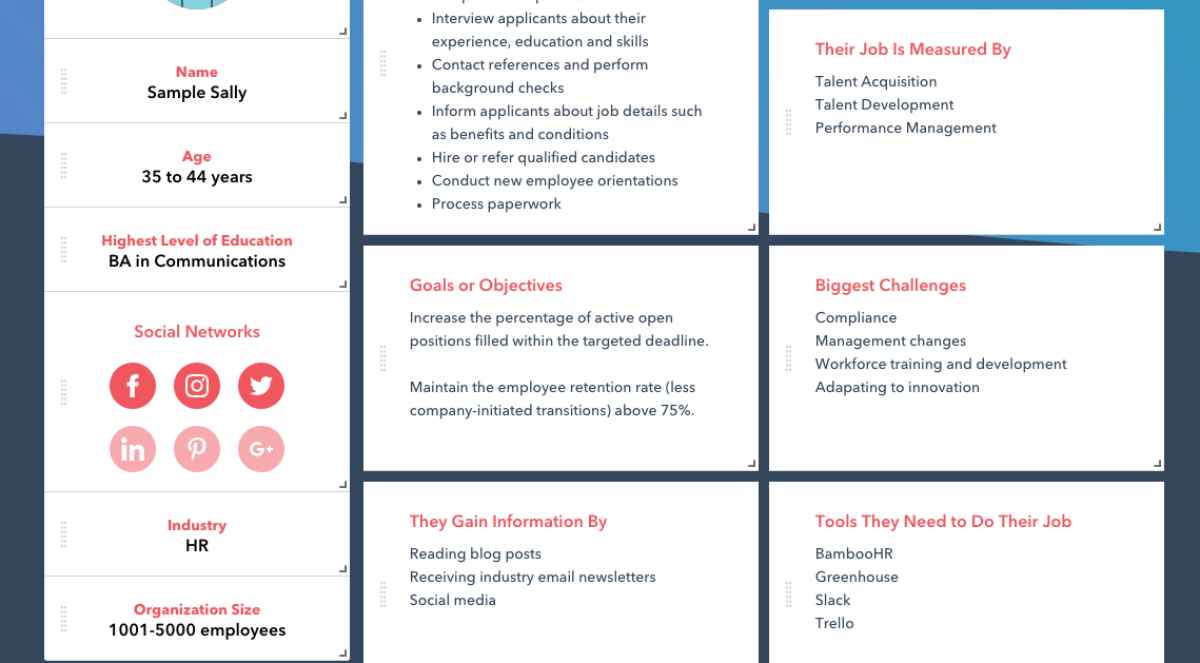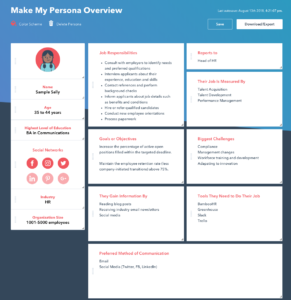Ever feel like your marketing efforts are a bit scattergun or you’re just throwing money at as many potential customers as possible? While that can have some positive results, you’ll see a much better return on your marketing investment when you sell to the people who actually need your product or service. And that’s where buyer personas come in.
Buyer personas are detailed profiles of your ideal customers which tell you everything you need to know in order to win their business.
Why you need buyer personas for your B2B marketing strategy
Defining your B2B buyer personas has numerous benefits. They provide an insight into your customers so that you can focus your marketing efforts more effectively. Take a very obvious example. If your ideal customer is based in Edinburgh then you don’t want to embark on an extravagant campaign in London. Similarly, when you know who you should be advertising to, you can rule out campaigns that target anyone outside of your personas.
Beneath the top of the funnel activities, having personas for your B2B marketing strategy can give you a good idea of how they’ll interact with the rest of the funnel. Are they the type of person who skims over emails and tune out when they’re longer than two sentences? Then you know to keep your continued communications short and to the point.
Having defined personas can help other areas of the business too. When you share them internally, personas can give account managers or customer service teams a good idea of the type of people they’ll be dealing with. From there, you can proactively create upsell content or FAQs which will resonate better and keep your customers engaged beyond just your marketing efforts. And your personas can improve the effectiveness of your product/service offering, as upgrades or new products can be made with them in mind.
What you need to know about your personas
As we touched on in the intro, you’ll need to identify some key details to really flesh your personas out as much as possible. This includes:
- Their job: What does your ideal customer do? How senior are they in the business? What kind of spending power do they have? How educated do they need to be to do that job? Do they manage other people? Are they the main stakeholder or will they need sign-off?
- Their business: Which industry do they typically work in? How big is their business? What product/service do they provide?
- Their pain points/challenges: What problems do they have? How do your products solve them? How do they look for solutions to their problems? Do they read blogs, watch videos or listen to podcasts?
- Their measure of success: What does success look like to them? What are their metrics for success? How does your product/service match up to those metrics?
- Their favoured brands: Which type of brands do they already interact with? Why do they favour these brands over others? What is it about their messaging/content that they like?
- Their purchasing habits: How do they like to be sold to? Do they prefer phone calls, emails or meetings in person? Are they led by their head or their heart?
How to gather persona data
Now you’ve got an idea of what you need to know about your personas, you’ll need to fill in the blanks. A great place to start is with your happiest customers. It’s a good bet that those customers will be your happiest because you solve their problems so well. And if that’s the case, you should look at the common factors between them and notice any patterns. When you start to find similarities between them, you can be confident that these aspects can be added to your personas.
Your current marketing efforts can also be a good place to start – especially those that are actively capturing leads. Have a look at the common thread between people who are filling out forms to download your content. The more similarities you see, the more you can be certain that you’re resonating with that type of buyer.
Purchasing the data you need is a great way to speed up your creation of buyer personas, and our online tool allows you to find key information which might otherwise be hard to come by. For example, you can see a live count of how many people in a certain area have a specific job. So, say you know your ideal customers are in-house recruiters, Marketscan can tell you where most of these work, so you know where to focus your marketing efforts.
When you’ve gathered the relevant data, don’t forget to speak to some of these people too. While data is great at creating logic around your personas, speaking with them directly will really help you dig into their psyché.
If you aren’t 100% sure who your best customers are then our Market Penetration report can help you to generate a profile of them so you can find more of the same. Our report can also let you know what other new prospects you might be missing out on.
How to bring your buyer personas to life
Just as we’re all physical manifestations of our individual data points, your buyer personas should also be brought to life. Give them a name so people can talk about them as if they exist. Find stock imagery that perfectly matches how you think they’d look or have illustrations of them drawn up. And add all of the information you know about them to an easy to digest document.
Hey, if you really wanted to go the extra mile, you could hire actors to play the role of your personas and have them spend a day with your business.
The key point here is to have a single document for each persona which people can understand with ease and refer back to when needed. Take a look at the example below from Hubspot for inspiration:
Before you go, have you seen our Christmas Countdown Calendar?
To bring some joy to a year that has had its ups and downs, we’re giving away a host of prizes in our Christmas Countdown Calendar. And we don’t want you to miss out on a chance to win!

